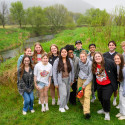On anniversary of Edmund Fitzgerald sinking, wave research may prevent future tragedies
The intense and dangerous windstorm and accompanying high waves the Great Lakes states experienced in late October is thought to be the same kind of storm that occurred on Lake Superior causing the fatal wreck of the ship Edmund Fitzgerald 35 years ago on Wednesday, Nov. 10.
A University of Wisconsin Sea Grant Institute-funded researcher is studying extreme waves in hopes of preventing future tragedies.
Extratropical cyclones are characterized by very strong winds carried over a long distance generating large waves. Buoys on the northern part of Lake Superior recorded waves as high as 27 feet in the recent storm. But the lake might have been even rougher during the Edmund Fitzgerald storm on Nov. 10, 1975, according to a scientific process called hindcasting, the opposite of forecasting.
Using a combination of observational data and computer modeling, scientists at NOAA’s National Weather Service and the Great Lakes Environmental Research Laboratory in Michigan show that sustained winds were likely blowing at 50 to 60 knots, roughly 57 to 69 miles per hour. Winds of that velocity would have generated waves about 24.6 feet high.
Such rough conditions could have produced an individual wave 46 feet high, although “rare and unlikely,” according to the NOAA scientists. No one will know exactly what caused the demise of the Edmund Fitzgerald because all 29 crew members perished. However, computer models showed that one such wave – known as a freak, rogue or giant wave – occurred at the exact time and location of the ship’s sinking.
Freak waves are exceptionally large, steep and asymmetric and often occur in the Great Lakes, according to University of Wisconsin–Madison researcher Chin-Hsien Wu. He is currently investigating the conditions and locations prone to producing the dangerous waves, which can take down a vessel like the Edmund Fitzgerald.
Freak waves can also be dangerous to kayakers and recreational boaters. Wu is particularly interested in the potential for rogue waves to occur in the Apostle Islands off the north shore of Lake Superior.
“The occurrence of extreme waves is still a mysterious phenomenon in the field of fluid mechanics,” said Wu, professor of civil and environmental engineering. The Apostle Islands include a complex network of islands and shoals that under the right wind conditions are likely to produce freak waves.
Using funds provided by the University of Wisconsin Sea Grant Institute, Wu is using a combination of wave gauge instrumentations and computer models to better understand the likelihood of extreme waves occurring at the Mawikwe Bay Sea Caves, a place that is popular, but also potentially dangerous, to sea kayakers who enjoy viewing the sea caves from the water.
Since wave measurements are critical for safety, data must be transmitted in real-time via a website to alert paddlers to current wave conditions. The system was field tested in the summer and could be fully operational next year.
Improving knowledge of how extreme waves are created should prove invaluable to prevent further tragedies like the sinking of the Edmund Fitzgerald. Several commemorative activities are planned for tomorrow, including in River Rogue, Mich., near where the ship was built in 1958.
UW Sea Grant video of the Chin Wu research at the Lake Superior sea caves can be found here and click on the video, “Increasing Safety on Sea Caves.”
— Carolyn Betz
Tags: research




